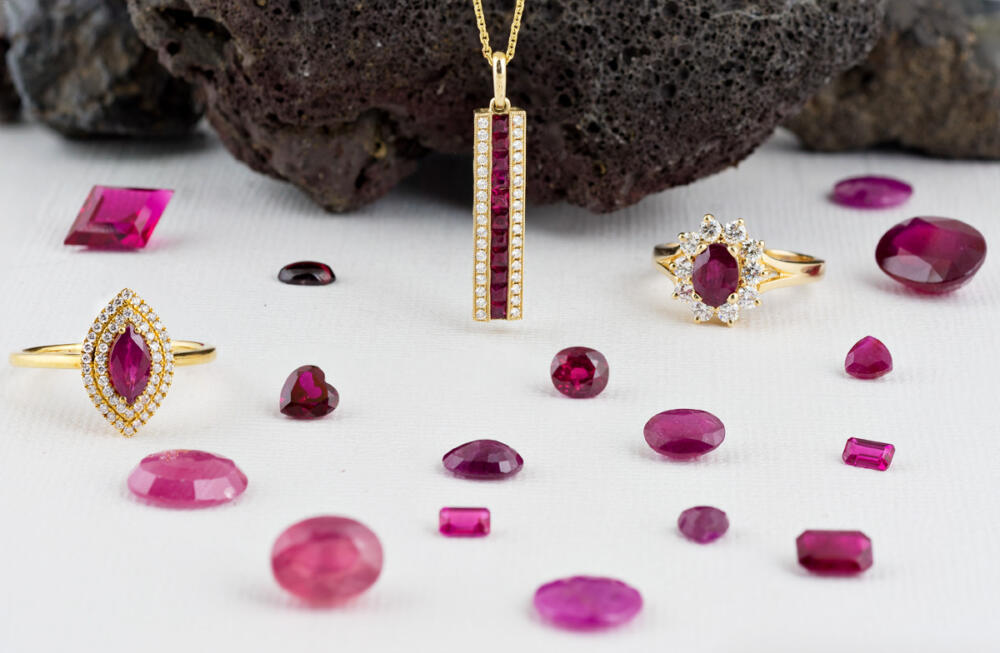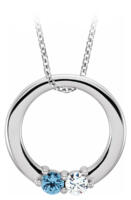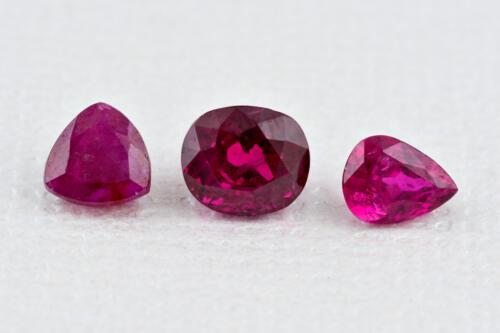Gem in the Spotlight: Ruby
The King of Precious Stones has been dazzling people for centuries
For much of human history, rubies have been the most prized gemstone. But, what is it about this red gem that has captivated our hearts and minds for so long? Is it ruby’s color? It’s rarity, and thereby its high cost? Or, is it something deeper? Whatever it is, ruby’s impact on humanity is broad and deep, with arguably the richest history of all gemstones.
Gemology of Ruby
Rubies are in the corundum gem family along with sapphires. Corundum is an extremely durable form of aluminum oxide with a Moh’s hardness of 9. This makes ruby one of the hardest gems commonly used in jewelry second only to diamond (which has a Moh’s hardness of 10) and moissanite (which is in between). Rubies only occur in the color red which comes from trace amounts of chromium in the crystal structure. If they are too purple or too pink, they are called purple sapphires or pink sapphires, respectively. Since sapphires and rubies are the same gem material, they also share a refractive index of 1.762-1.770 and a specific gravity of 4.00.
A unique optical property of rubies is that they emit fluorescent light at a very specific wavelength (694 nanometers) under certain conditions. Scientists used this fact to build the world’s first functioning laser in 1960 using a flashlamp and a synthetic ruby. This amazing machine demonstrated the concept first described by Albert Einstein over 40 years earlier in 1917.
Rubies are formed under extreme pressure and temperature in metamorphic rocks such as marble, gneiss, and schist. The most famous source of rubies is Myanmar (formerly known as Burma), where rubies were first discovered more than 4,500 years ago. Other significant sources of rubies include Thailand, Vietnam, Sri Lanka, Tanzania, Mozambique, and Madagascar.
Before modern gemology, for thousands of years, garnets, rubies, and spinel have been mistaken for each other. Famously, the Black Prince Ruby (formerly thought of as the largest cut ruby) at the center of the British Imperial State Crown, is actually a red spinel.
History and Lore of Ruby
The first discoveries of ruby date back to 2,500 B.C. They were found alongside stone age tools in historic mines in Mogok, Myanmar. The Bible compares the price of wisdom to the price of rubies and mentions them four separate times. In India, the ruby is known as “ratnaraj” or “king of precious stones” in the ancient language of Sanskrit.
Rubies get their name from the Latin word “ruber,” which means red. This is also where rubellite tourmaline (the red variety of tourmaline) gets its name. Pliny the Elder mentioned rubies in his work Natural History, including notes on their durability, which means that their physical properties have been known well for over 2,000 years.
For much of human history, rubies have been the most prized gemstone.
The ruby has always been a symbol of love, charity, and victory. The earliest cultures worshiped rubies, calling them “perpetually burning fires” and ascribing to them magical powers. In ancient days, the fiery stone was associated with courage, red blood, and fire. Worn on the crowns and helmets of kings, rubies were a royal insignia believed to protect the wearer from injury and to keep them safe and healthy. Many cultures believed that wearing rubies in battle made warriors invincible and protected them from harm.
Innumerable powers have been associated with the ruby throughout time. It was thought that the ruby could preserve health, remove evil thoughts, and settle disagreements. Rubies are also believed to aide physical and spiritual regeneration, enhance circulation, vitalize blood, strengthen immunity, activate sluggish or dormant conditions, and help banish a sense of limitation. Continuing on, ruby refines lower passions, bolsters courage, and increases integrity.
Another fascinating aspect of rubies is their association with dragons. In ancient Chinese mythology, dragons were often depicted holding or guarding precious rubies, which were believed to represent their fiery breath and fierce power.
Today, ruby is recognized as the birthstone for July and the traditional gift for the 40th wedding anniversary.
Notable Rubies
Throughout history, rubies have been worn by royalty, nobility, and the wealthy as a symbol of power and success. The Sunrise Ruby is not only the most expensive ruby in the world, it is the most expensive colored gemstone in the world. Weighing in at 25.59 carats, this ruby may not be the largest ruby ever found, but its color and cut is unrivaled.
It is the most famous ruby, and was originally mined in Myanmar. The Sunrise Ruby was eventually set by Cartier into a ring along with two diamonds weighing a total of 5 carats. In 2015, Sotheby’s put the ring up for auction where it sold for a record setting $30.42 million dollars to an anonymous Swiss buyer.
Care and Cleaning of Ruby
Rubies are sturdy stones, but are still vulnerable to breakage and chipping. Don’t apply hairspray, makeup, lotions and the like while wearing rubies. They can leave residue on the ruby that will dull their shine. Some rubies may have been filled or treated to hide surface scratches or inclusion. Avoid using household chemicals or abrasives when wearing them.
Ruby jewelry can be wiped with a soft, dry cloth often to remove dust and residue that will mar its sparkle. For more intense cleaning, use warm water and mild dishwashing detergent in solution. Soak the piece for 15 minutes, and then clean with a soft brush. Rinse with clear water and examine under good light for any remaining residue. If there is any, repeat the process. You can use an ultrasonic cleaning machine with rubies, but use caution as these machines can cause loose gems to come out of their settings. Remember to dry your ruby jewelry thoroughly before wearing or storing.
Why Ruby?
Rubies are a truly remarkable gemstone with a long and rich history. From their association with royalty and dragons to their mystical healing properties and beautiful color, there is no denying that rubies have captured the imagination of people for centuries. Whether you are a gem collector, a jewelry lover, or simply appreciate the natural beauty of the world, rubies are definitely a gemstone worth owning.
If you are looking for a fantastic new piece of ruby jewelry, please reach out to us anytime. We would love to create something together or help find that one-of-a-kind antique piece you’ve been searching for.





I would like to know if this particular pendant is available. (Fiery red Ruby is one of the most striking and beautiful gemstones) If it is, please let me know the actual size and price.
Thank you!
Hi Marie, thanks for reaching to us. I just sent you an email with information on that pendant.